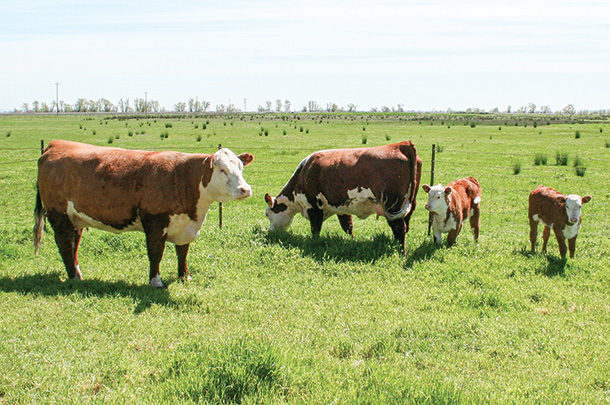I don’t know many people who are giddy about change, but the people I know who seek out positive change are highly successful. Like it or not, it’s the new constant in everything we do.
Change on our cow-calf operations is no exception. I’m not going to tell you to be the person who changes all the time just for the sake of changing, but I am going to challenge you to think about the “what if’s” as they relate to your operation. In doing so, I’ll ask for your commitment to consider and implement change when the time is right and before you’re forced to.
The cow business is built on tradition. So let’s focus on traditions to keep, traditions to break and traditions to start.
Traditions to keep
First and foremost, we’ve got to maintain our passion for this industry. Love what you do and why you do it. This would be a rough business to be in if you didn’t enjoy it. At the same time, don’t negate the goal of profitability and, in doing so, be frugal. Please note I said frugal, not cheap. The difference means optimizing efficiency for your cow herd to remain profitable, not just cutting cost for the sake of cutting cost. Finally, it’s imperative you stay focused on the welfare of your herd and old-fashioned animal husbandry. Nutrition is a key part of both of those areas.
Traditions to break
Number one is to stop thinking about supplementation as a necessary evil. Only half of that is true – it’s necessary. Without context, it’s easy to see your nutrition program as a big expense, but the reality is: It is an investment. You are investing in the longevity and sustainability of your herd. Why would you view that as a negative?
Second, I challenge you to stop just assuming everything is fine. Sure, there might not be any noticeable holes in your program, and maybe you’re doing well financially, but is there really nothing on your operation that could be improved? Why be happy with being just “OK”?
Finally, you’ve got to stop viewing your forage base, your cows’ needs and your supplementation program as static. It’s pretty easy to see how your forage changes with the seasons throughout the year, and basic animal science teaches us that our cows’ needs are going to fluctuate dramatically depending on the stage of production. So if the two things that drive the need for a supplementation program are dynamic, why assume the supplementation program itself should stay the same?
Nutrition fundamentals
I’ll be the first to tell you that you should be wary of anyone who stands in front of you and makes blanket recommendations about your operation, especially if they’ve never set foot on your place. The cow-calf industry in the U.S. is as variable as the geography itself, so specific nutritional recommendations have to be, as well.
However, there are a few things I want to challenge you to think about as you consider changes that can help drive your operation forward. Drive is a key term here. You have to get back there and push.
Reproduction is the common denominator when it comes to goals of cow-calf operations across the nation. We have to get cows bred and have them produce healthy calves to make a living. When it comes to reproduction, there are things out of your control that might affect your herd’s success. As many things that are out of your control, there are twice as many common causes of reproductive failure in cattle that are directly influenced by your nutrition and health decisions.
If you consider a year in the life of a perfect cow, she’s calving every 12 months to offer the most profitability. It sounds easy enough, but when you consider the fact that you have only about 24 hours to get her bred every year, you’ve got to think about what you’re doing up to that point to capture that breeding success. A missed breeding opportunity means another 21 days until you have another chance for that cow to breed. Twenty-one days’ difference in when a calf could be on the ground and gaining equates to approximately 42 pounds of calf lost per cow, or $50 to $60 in today’s market. Do you have that much wiggle room in your profit margin?
So what can you do about it? Lots of things. As I said before, I’m not going to offer blanket recommendations, but here are a few things I’m confident everyone should think about:
-
Don’t discount the importance of calories. Body condition is a major factor in reproductive success. The basic understanding of calories in versus calories out that we know and understand in human nutrition also applies to cattle. When a cow is consuming more calories than she is burning, she will gain weight. When she’s burning more than she’s consuming, she will lose weight. When she’s burning and consuming the same number of calories, she will maintain weight. Where is she now and where does she need to be throughout her production cycle?
-
Fetal programming matters. The better care we give to a cow during gestation, the more likely her progeny are to succeed for your operation. Just the effects fetal programming has on replacement heifers means the decisions you make here can affect you for good or bad for literally a decade.
-
Don’t neglect a cow’s nutritional requirements. They are going to be the lowest in her year during the second trimester, but even that time frame will impact her and her calf’s success. If she’s just getting by in the second trimester, how can you expect her to make up for that and then some when her gestational cycle is demanding more in trimester three? Align your supplementation program with her nutritional demands and her environment. If you aren’t sure how to do that, ask for help. There are plenty of experts out there who can help you get her what she needs most efficiently.
-
Pay attention to your heifers. They are the future of your herd. Keep them in the proper condition for breeding and calving success. Keep records of which heifers breed first and make sure you’re keeping those to make your herd as efficient as possible.
- Collect data and use it. You can’t manage what you don’t measure, and your cow herd is no different. If you’re not keeping track of things like conception rates, birthweights, breeding dates, etc., why aren’t you? More importantly, if you are tracking these things but not using this data to inform decisions, shame on you. Most of what we can measure in the cow-calf space is a lagging indicator. That is, it helps us spot problems once it’s too late to do much about them. However, you can look at trends over time and use that to make changes which will hopefully prevent future train wrecks. Set goals for your operation and use the data you collect to measure against those goals and inform goal-setting for every year to come. I am convinced now, more than ever, that traceability back to the cow-calf operation is coming. What can you do now to better understand your operation and the implications of your management practices before you’re inevitably forced to change?
Traditions to start
What should you start doing now to better equip your operation for the future?
First and foremost, look for problems before they happen and ask what I believe is one of the most powerful questions you can ask yourself: “What if?” If you aren’t 100% certain you have the right/best answer to those what if questions, seek it out by engaging the experts. Your time is limited, and there are professionals in the industry and extension services with expertise in all areas of cow-calf production. Leverage them to understand more. Learning is key to improving.
Second, be open-minded and don’t forget to think about the cow’s whole year – not just the periods where you’re more hands-on or when it’s crunch time to make a profit.
And, finally, the best tradition you can start today is committing to getting better. I’ve never heard anyone say they worked on improving something too soon or wished they had waited longer to start. There is always room for improvement and, if you’re willing to make that a mantra for your operation, you can only get better from here.








